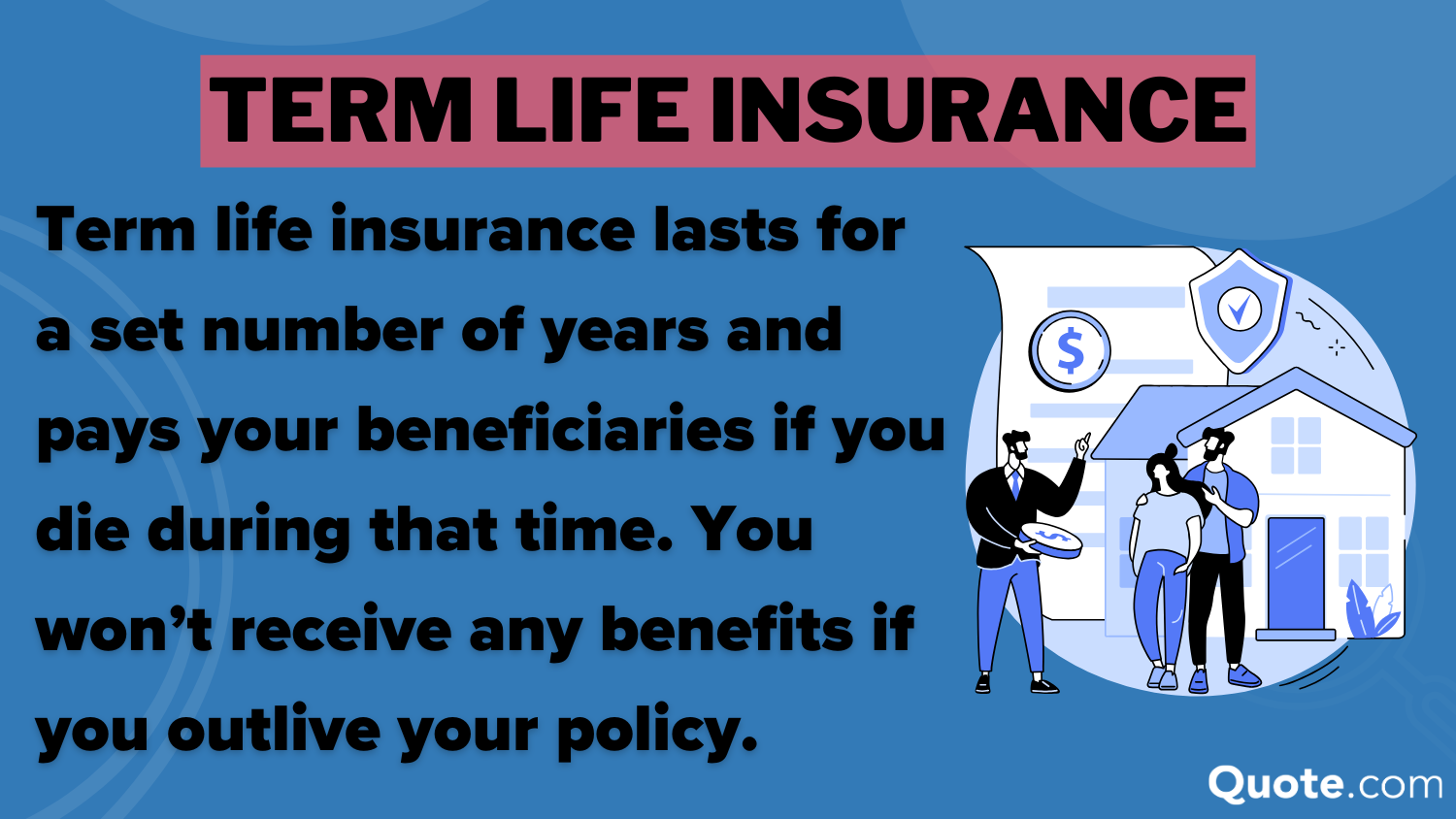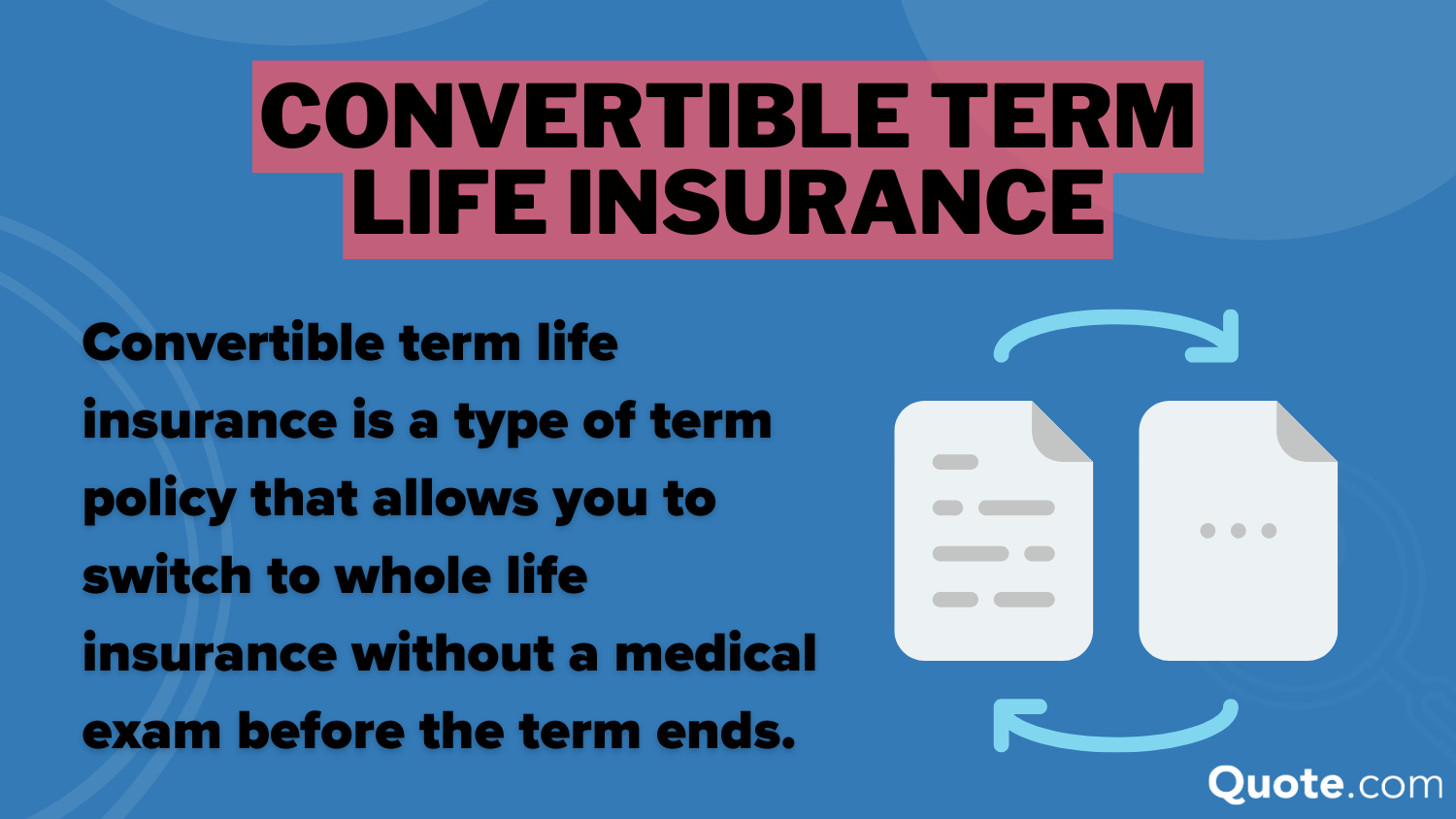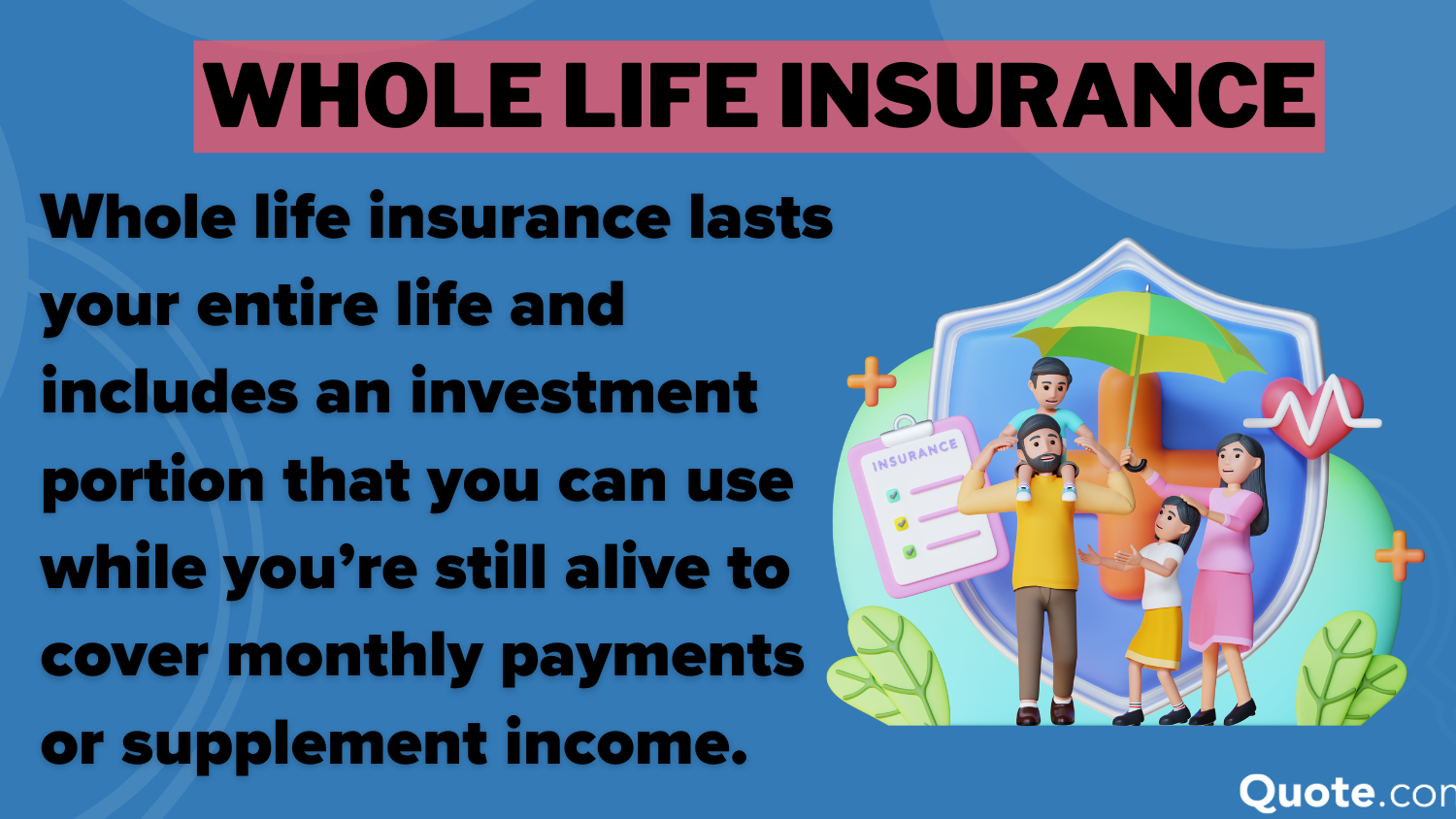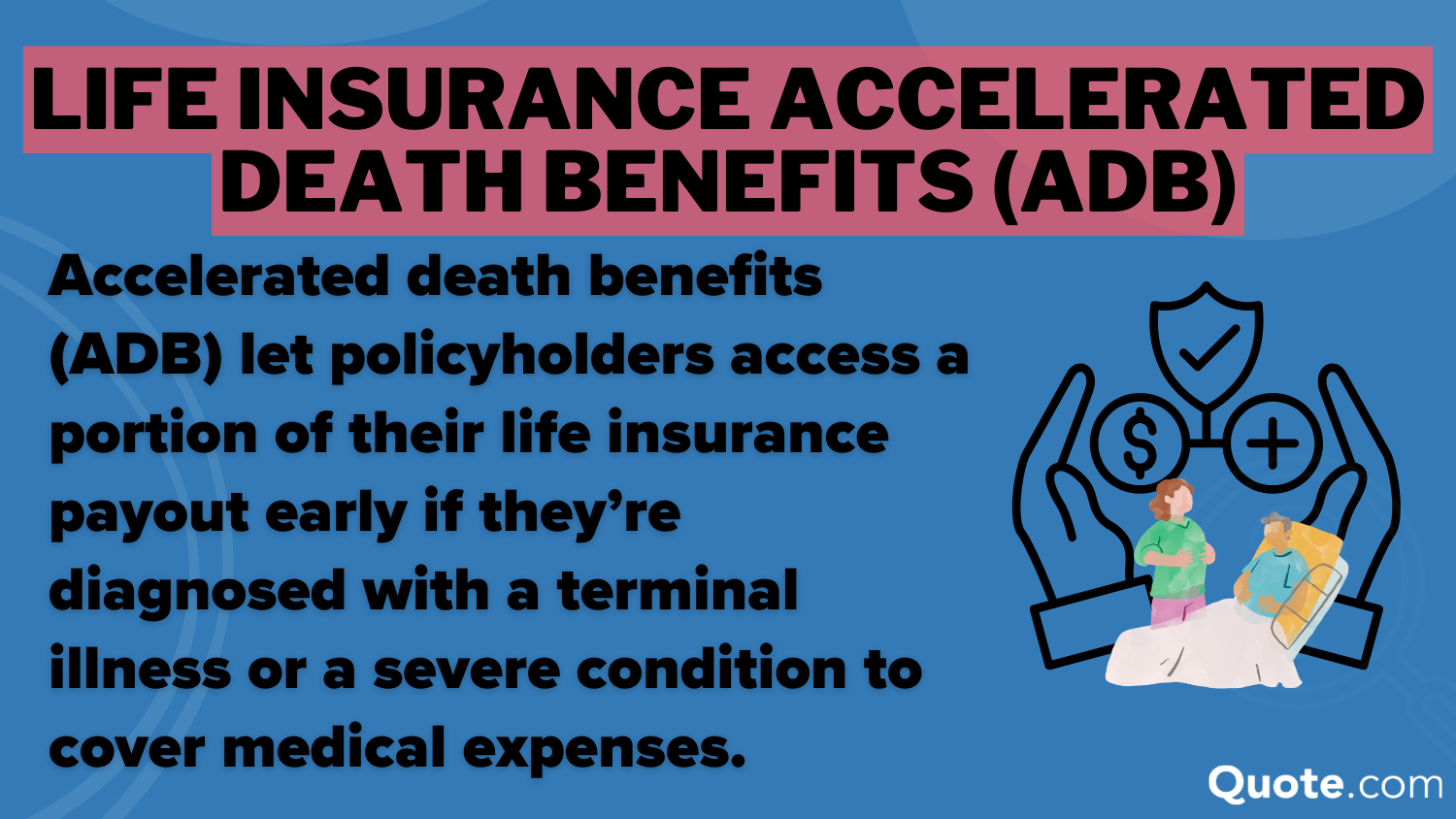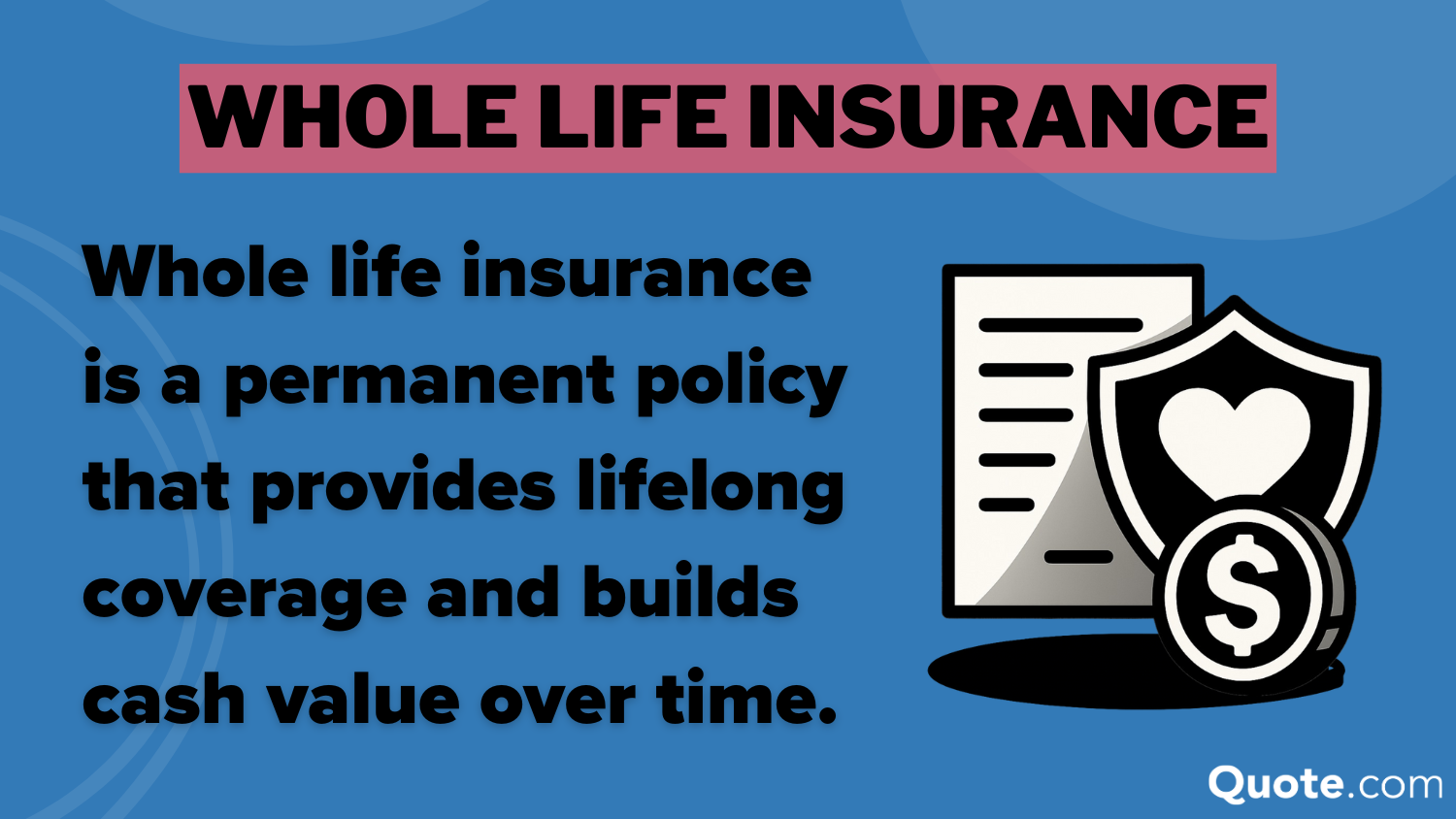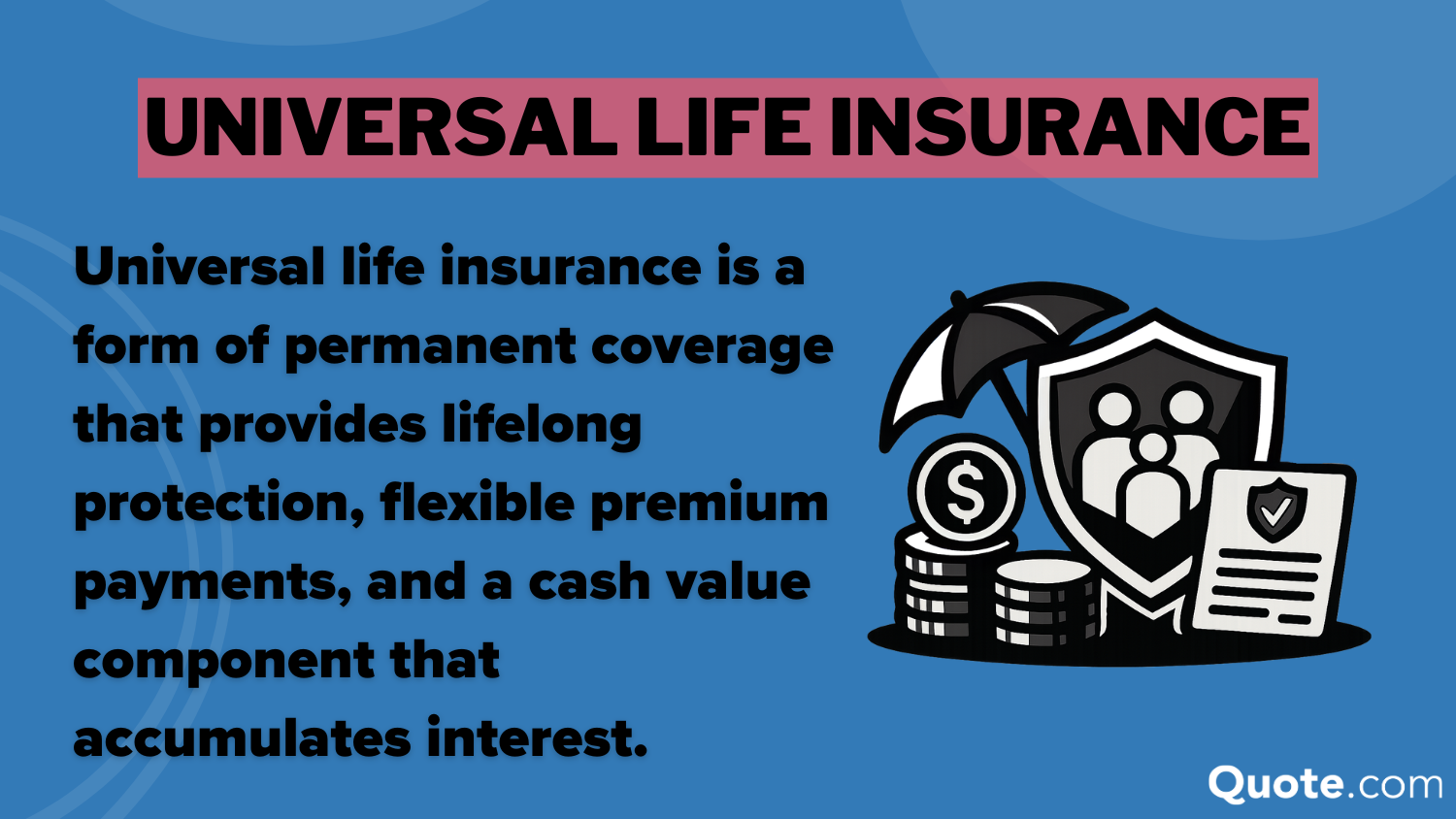Whole vs. Term Life Insurance in 2025: Differences Explained (+What You Need)
The main difference between whole vs. term life insurance is cost. Term life insurance rates start at $20/month, while whole costs around $150 monthly. However, whole policies lock in life insurance premiums for your entire life. Term life rates increase annually, and coverage only lasts between 10 and 40 years.
Read more Secured with SHA-256 Encryption




Table of Contents
Table of Contents


Head of Content
Meggan McCain, Head of Content, has been a professional writer and editor for over a decade. She leads the in-house content team at Quote.com. With three years dedicated to the insurance industry, Meggan combines her editorial expertise and passion for writing to help readers better understand complex insurance topics. As a content team manager, Meggan sets the tone for excellence by guiding c...
Meggan McCain


Senior Director of Content
Sara Routhier, Senior Director of Content, has professional experience as an educator, SEO specialist, and content marketer. She has over 10 years of experience in the insurance industry. As a researcher, data nerd, writer, and editor, she strives to curate educational, enlightening articles that provide you with the must-know facts and best-kept secrets within the overwhelming world of insurance....
Sara Routhier


Licensed Insurance Broker
Zach Fagiano has been in the insurance industry for over 10 years, specializing in property and casualty and risk management consulting. He started out specializing in small businesses and moved up to large commercial real estate risks. During that time, he acquired property & casualty, life & health, and surplus lines brokers licenses. He’s now the Senior Vice President overseeing globa...
Zach Fagiano
Updated October 2025
What’s the difference between term and whole life insurance? Whole and term life insurance protects those who rely on you financially, but each policy has unique benefits and risks. Before buying a policy, you should know the differences between whole vs. term life insurance. Term life insurance costs less and covers short-term debts. Permanent life insurance lasts a lifetime.
- Term life insurance coverage typically lasts 10 to 30 years
- Whole life insurance locks in rates and coverage for a lifetime
- Whole life premiums can be invested to cover policy costs later in life
Is it better to have whole life or term life insurance? Term life is cheaper, but permanent plans can complement 401(k), Roth IRA, IRA options, and 529 plans. Use this life insurance guide to compare policies by age, gender, and state to find the best possible protection.
Before buying a policy, you should know the differences between whole vs. term life insurance. Term life insurance costs less and covers short-term debts. Permanent life insurance lasts a lifetime. Enter you ZIP code to find cheap life insurance companies near you.
Whole vs. Term Life Insurance: Pros and Cons
Cheap rates and simple policy terms are the most common reasons why people buy term life insurance instead of whole life.

Scroll down to compare insurance plans and get a closer look at the pros and cons of whole vs. term life insurance coverage.
Risks and Benefits of Term Life Insurance
If you’re considering short-term coverage, here is a list of the top three reasons to get a term life policy over permanent life insurance:
- Cheaper Rates: Term life is the most affordable type of protection you can purchase.
- Simple Policy Terms: As long as you pay your premiums, your provider will compensate your beneficiary the agreed amount if you pass during the policy’s term. There is no hidden cost.
- Conversion Options: You can cancel term life insurance at any time, even before it expires, or convert it into whole life insurance at the end of the term.
Although it’s a straightforward and affordable type of life insurance, there are a few cons of term life coverage you should be aware of:
- Rate Hikes: Once the term expires, your monthly term life insurance rate can significantly increase.
- No Cash Value: Once you outlive the policy term, you get nothing back unless you have purchased the return-of-premium feature at additional cost.
- Age Restrictions: Some life insurance companies will not sell term coverage to policyholders over a certain age.
The biggest risk of term life insurance is losing your investment if you outlive your policy. You can buy add-ons to protect your premiums or lock in rates at conversion, but these will raise your monthly rates.
Risks and Benefits of Whole Life Insurance
On the surface, whole life coverage can seem like an exclusive investment for the top-earners crowd. However, whole life coverage never expires as long as you keep paying the minimum premium amount as stated by your company.
Take a deeper look at these benefits of whole life insurance:
- Locked-In Premiums: Whole life insurance rates will never increase as you get older, and you can lock in the lowest rates if you buy coverage before you turn 40.
- Accelerated Death Benefits: This whole life insurance add-on can be a life-saver if you’re diagnosed with a terminal illness or life-changing injury. You can take out a percentage of the death benefits to pay for medical bills and lost wages.
- Cash Value: Part of the premium is deposited into a cash reserve that works as a safety net to cover monthly payments. You’re allowed to take cash out without paying tax penalties, and your cash value will be refunded back to you if you end the policy before you pass.
Whole life insurance cash value will grow yearly, and the dividends you earn are not taxable. Unlike cash, properties, and jewelry, heirs have access to whole life insurance death benefits without any taxation.
On the other hand, the earned interest from the deposit is still regarded as taxable interest income.
Keep all your receipts as proof that you're always on time with life insurance payments. Errors and mishandling situations can create a lapse. For term plans, that can become a way for companies to drop your coverage.
Michelle Robbins Licensed Insurance Agent
Buying whole life insurance requires some knowledge of finance and investment strategy as there are many options to customize your plan to suit your goals and needs.
To avoid being penalized, consult your portfolio agent or accountant, and consider this list of whole life insurance cons before you buy:
- Expensive Premiums: Whole life insurance is more expensive than average, and many policyholders tend to buy less coverage than they truly need in an attempt to save money.
- Investment Risks: How much your cash value grows will depend on how well you set up your foundation during the early years of the plan and the volatility of the market.
- Tax Season Stress: The cash value gain and loss and your interest growth from the reserve accumulation can make tax preparation much more confusing.
Ultimately, if you wish your beneficiaries to avoid being taxed in the transferal of your inheritance, adding whole life insurance protection to your portfolio is a good option.
Term life insurance is a better fit if you only need short-term coverage to pay any debts if you die unexpectedly.
Read More: Colonial Life and Accident Insurance Review
Free Life Insurance Comparison
Compare Quotes From Top Companies and Save
Secured with SHA-256 Encryption
Comparing Term and Whole Life Insurance Quotes
When you’re comparing the two policy types, the most obvious whole and term life insurance difference is price. Term life is cheaper than permanent plans.
How much more expensive is whole life insurance than term? Here is a whole vs. term life calculator chart of the ten largest life insurance companies in the U.S.
Whole vs. Term Life Insurance Monthly Rates by Provider & Policy| Insurance Company | 15-Year Term | 20-Year Term | 30-Year Term | Whole Life |
|---|---|---|---|---|
| $35 | $45 | $60 | $150 | |
 | $34 | $43 | $58 | $145 |
| $33 | $42 | $55 | $140 | |
| $32 | $40 | $53 | $135 | |
| $31 | $38 | $52 | $130 | |
| $30 | $37 | $50 | $128 | |
 | $29 | $36 | $48 | $125 |
| $28 | $34 | $47 | $120 | |
 | $27 | $33 | $45 | $118 |
| $26 | $32 | $43 | $115 |
Term life insurance is the most popular type of coverage because it’s so affordable. Even as 30-year term life insurance rates increase, permanent protection packages still tend to be more expensive.
Take advantage of our whole vs. term life quotes comparison charts below to get a complete view of monthly costs from the best life insurance companies in the country.
Comparing Life Insurance Quotes from the Best Companies
Being the biggest provider doesn’t necessarily mean it’s the best. This whole life insurance rates chart lists free quotes from some of the most popular life insurance companies in the U.S. Compare these rates to the largest companies above to see which is the cheapest.
Life Insurance Monthly Rates by Policy Type| Insurance Company | 20-Year Term | Whole Policy |
|---|---|---|
| $27 | $210 | |
| $26 | $200 | |
| $25 | $195 | |
| $28 | $215 | |
| $24 | $190 | |
| $26 | $205 | |
| $30 | $230 | |
 | $25 | $200 |
| $23 | $185 | |
| $27 | $210 |
State Farm is the only life insurance company to make both lists, thanks to its stellar customer service and claims reviews. However, it has a lower financial strength rating than other providers. Learn more in our State Farm insurance review.
One of the easiest ways to find out whether a provider is trustworthy is to research its financial strength through rating websites like A.M. Best. The score will be based on the company’s financial health and its ability to pay the benefits.
You should look into the customer service reputation of a company. You can can find out a provider’s customer dissatisfaction and complaint ratio grade on the National Association of Insurance Commissioners (NAIC) website. You also have the right to look up your agent’s credential, licensing, and complaints information on the NAIC website.
Comparing Whole vs. Term Life Insurance Costs by Location
Life insurance rates differ depending on where you live. Use this table to compare whole vs. term life insurance quotes by state:
Whole vs. Term Life Insurance Monthly Rates by State and Policy| State | 15-Year Term | 20-Year Term | 30-Year Term | Whole Life |
|---|---|---|---|---|
| Alabama | $18 | $24 | $35 | $150 |
| Alaska | $20 | $28 | $40 | $155 |
| Arizona | $19 | $25 | $36 | $148 |
| Arkansas | $18 | $23 | $34 | $145 |
| California | $21 | $27 | $39 | $160 |
| Colorado | $19 | $26 | $37 | $150 |
| Connecticut | $22 | $30 | $42 | $170 |
| Delaware | $19 | $25 | $36 | $155 |
| Florida | $21 | $29 | $40 | $165 |
| Georgia | $20 | $26 | $37 | $152 |
| Hawaii | $19 | $26 | $36 | $153 |
| Idaho | $18 | $23 | $34 | $140 |
| Illinois | $19 | $25 | $36 | $150 |
| Indiana | $18 | $24 | $35 | $148 |
| Iowa | $17 | $23 | $33 | $142 |
| Kansas | $18 | $24 | $35 | $145 |
| Kentucky | $19 | $25 | $36 | $148 |
| Louisiana | $20 | $26 | $38 | $155 |
| Maine | $18 | $23 | $34 | $140 |
| Maryland | $20 | $27 | $39 | $160 |
| Massachusetts | $21 | $28 | $40 | $165 |
| Michigan | $20 | $26 | $37 | $155 |
| Minnesota | $19 | $25 | $36 | $150 |
| Mississippi | $18 | $24 | $35 | $145 |
| Missouri | $19 | $25 | $36 | $148 |
| Montana | $18 | $24 | $35 | $145 |
| Nebraska | $17 | $22 | $33 | $140 |
| Nevada | $20 | $27 | $38 | $155 |
| New Hampshire | $19 | $25 | $36 | $150 |
| New Jersey | $21 | $29 | $40 | $165 |
| New Mexico | $19 | $25 | $35 | $148 |
| New York | $22 | $30 | $42 | $170 |
| North Carolina | $19 | $25 | $36 | $150 |
| North Dakota | $17 | $22 | $33 | $140 |
| Ohio | $18 | $24 | $35 | $148 |
| Oklahoma | $19 | $25 | $36 | $150 |
| Oregon | $19 | $25 | $36 | $150 |
| Pennsylvania | $20 | $26 | $37 | $155 |
| Rhode Island | $19 | $25 | $36 | $150 |
| South Carolina | $18 | $24 | $35 | $148 |
| South Dakota | $17 | $22 | $33 | $140 |
| Tennessee | $19 | $25 | $36 | $148 |
| Texas | $19 | $25 | $36 | $150 |
| Utah | $18 | $24 | $35 | $145 |
| Vermont | $19 | $25 | $36 | $148 |
| Virginia | $19 | $25 | $36 | $150 |
| Washington | $20 | $26 | $38 | $155 |
| West Virginia | $18 | $24 | $35 | $145 |
| Wisconsin | $18 | $24 | $35 | $148 |
| Wyoming | $19 | $25 | $36 | $150 |
By checking mortality tables and comparing your region and state with other states’ payout statistics, a company may increase or decrease the average premium rate based on whether the area:
- Has a higher rate of obesity
- Has a higher frequency of serious natural disasters such as flood, tornado, and earthquakes
- Is prone to deadly illnesses or diseases
- Has a high crime rate
The number of policies sold in your state will impact premiums, and there can be different laws to mandate specific minimal coverages and how much companies can charge for a package.
State insurance laws also regulate the underwriting process, grace periods, customer privacy rights, medical examination requirement, and death benefit payouts.
Kristen Gryglik Licensed Insurance Agent
Before you shop around for term vs. whole life insurance, it’s a great idea to visit your state’s life regulation agency for information. You can find a list of state insurance departments at the Insurance Information Institute (III).
Read More: What does the Insurance Institute for Highway Safety do?
Term Life Insurance Explained
Term life insurance packages offer a limited time coverage for your dependents should you pass away before the set term terminates.
If that occurs, the insurer will honor the agreement to settle your debts and estate taxes, as well as pay your beneficiaries a set amount of money as stated in the contract.
Term life policies can range from one year to 30 years. Some providers have coverage that can last 40 years or up to a set age as set in the policy contract.
There are five types of term coverages. These policies are best for people who do not have a large financial portfolio but wish to secure a form of inheritance for their beneficiaries:
Term Life Insurance Policy Types Explained| Policy Type | Policy Description |
|---|---|
| Level Term Life | Death benefit remains the same throughout the term policy length. |
| Decreasing Term Life | Death benefit decreases by monthly or annual increments over the term policy length. |
| Renewable Term Life | Death benefit remains the same, but premiums increase every year you renew. |
| Convertible Term Life | Policy converts to a whole life policy during an indicated interval of time without a medical exam. |
| Return of Premium Term Life | This add-on will refund premiums if you outlive the term policy expiration. |
Among the types of term life insurance, decreasing term policies have cheaper rates. But this type of plan will not offer future security because it only provides the right amount of coverage if you anticipate paying off all your debts.
So, unless a person has a very specific financial goal, people usually opt for level term or convertible term policies. Compare the best term life insurance companies.
Convertible term life insurance affords you the opportunity of getting cheaper rates upfront and upgrading to permanent coverage later. Whole life insurance rates will be cheaper since you can often bypass the medical exam as a term policyholder, and many providers offer loyalty discounts to customers who convert coverage.
Just be sure to learn everything you can about the process. Ask your provider what will happen to the benefits and how conversion will that affect your premium. You should also ask what will happen if your health has deteriorated during the policy’s term.
Read More: MassMutual Insurance Review
Term Life Insurance Premium Costs
Full term life insurance quotes are heavily dependent on your age and health at the time of the purchase. In general, the younger and the healthier you are, the lower your premium.
The next crucial factor is the length of coverage — a shorter duration will usually have a lower price than longer terms. Use this term life insurance rates chart to compare costs:
Term Life Insurance Monthly Rates by Age, Gender, & Policy| Policyholder | 10-Year Term | 15-Year Term | 20-Year Term | 30-Year Term | 40-Year Term |
|---|---|---|---|---|---|
| 20-Year-Old Male | $12 | $15 | $20 | $25 | $35 |
| 20-Year-Old Female | $11 | $14 | $18 | $23 | $33 |
| 30-Year-Old Male | $15 | $18 | $24 | $30 | $42 |
| 30-Year-Old Female | $14 | $17 | $22 | $28 | $39 |
| 40-Year-Old Male | $20 | $25 | $32 | $42 | $58 |
| 40-Year-Old Female | $18 | $23 | $30 | $40 | $55 |
| 50-Year-Old Male | $35 | $45 | $60 | $80 | $105 |
| 50-Year-Old Female | $32 | $42 | $55 | $75 | $100 |
| 60-Year-Old Male | $65 | $85 | $110 | $140 | $185 |
| 60-Year-Old Female | $60 | $80 | $105 | $135 | $180 |
However, there are some longer term packages that guarantee your monthly payment will not increase during a certain period of time. For other plans, the company may guarantee you that rates only increase to a certain price and plateau afterwards.
Whole Life Insurance Explained
Whole life is almost the opposite of term life insurance since permanent policies guarantee protection for the policyholder’s entire lifetime or to the maturity date of the plan from the day the plan is activated.
All types of coverage last for your entire lifetime (unless you default on your premium payments) and accrue cash value that be used to either lower your monthly cost or increase the death benefit payout. You can use the savings for investment, lowering premiums, skipping payments, or put it towards a higher payout for your beneficiaries.
Whole Life Insurance Policy Types Explained| Policy Type | Policy Description |
|---|---|
| Traditional Whole Life | Coverage lasts a lifetime with fixed premiums and death benefits, and policies accrue cash value. |
| Variable Whole Life | Same as traditional whole life but customers can invest the cash value in an account managed by the provider. |
| Universal Whole Life | Death benefits increase as long as you pass a medical examination, with more investment options for cash value. |
| Variable Universal Whole Life | Same as universal life, with additional investment opportunities and flexibility. |
| Guaranteed Whole Life | Coverage doesn't require a medical exam, but it only pays for funeral and burial costs. |
You may also opt for survivorship life insurance. This type of whole life plan is used to cover two lives with one policy. It’s best for spouses where if one person passes away, the other will receive the death benefits. It is an affordable alternative for insuring two people at the same time without buying two separate policies.
Read More: Prudential Insurance Review
Free Life Insurance Comparison
Compare Quotes From Top Companies and Save
Secured with SHA-256 Encryption
Whole vs. Term Group Life Insurance Options
Certain companies offer their employees a chance to buy life insurance under a group plan for a discounted rate, and employers can chip in and cover premiums as part of the worker benefits. Here’s a closer look at the types of whole vs. term life insurance available with most group plans:
Benefits of Whole vs. Term Life Insurance Comparison Chart| Policy Type | Premium Cost | Face Amount | Cash Value |
|---|---|---|---|
| Term Life | Increases With Age | Renewable | None |
| Whole Life | Fixed | Level | Yes |
| Universal Whole Life | Flexible | Adjustable | Yes |
| Variable Whole Life | Fixed | Level | Yes |
| Variable Universal | Flexible | Adjustable | Yes |
For group plans, a physical examination is usually not needed. And the best states for employer-provided insurance mandate that employees have the right to convert term life into permanent policies once the existing group policy reaches the termination date.
Whole vs. Term Life Insurance Accelerated Death Benefits (ADB)
This optional add-on feature allows the policyholder to finance what health insurance won’t cover. In order to qualify for ADB, you must be diagnosed with an:
- Acute Illness: Includes severe heart diseases, HIV, hepatitis B, and hepatitis C
- Terminal Illness: Any illnesses with a life expectancy of less than 24 months
- Catastrophic Illness: Includes leukemia, heart attack, stroke, or any illnesses that require extreme treatments such as organ transplant or amputation
As medical treatments and hospital stays can be extremely expensive, even with health insurance benefits, some individuals have the option to use part of the death benefits. You can it take out as a cash advance against the payout for treating a terminal illness. Depending on the company and on the packages, some plans already come with this benefit whereas others require a small add-on fee.
No company can cancel your plan if you develop an illness, but you won’t get accelerated benefits if you didn’t add this rider to your whole or term life policy.
How much does an accelerated death benefits rider pay out? The actual sum depends on your company, policy value, state regulations, and the contract terms.
The general ADB advance cash withdraw ranges between 25 to 95% of the death benefit. For certain companies, it will go as far as allowing a 100% withdrawal in extreme circumstances.
Ty Stewart Licensed Insurance Agent
Also note that the withdrawal method can also differ based on the company’s regulations. For some, they may pay out as monthly stipends, others will pay in a lump sum, and there will also be ones who will allow you to choose.
If any company attempts to deny you coverage in this circumstances, contact your state’s agency and report of such activity.
How to Save Money on Whole vs. Term Life Insurance Costs
Medical history will impact your life insurance rates. For instance, an anxiety and life insurance quotes comparison can get expensive if you have a long history of prescriptions or involuntary treatments. Fortunately, there are many ways to save money on life insurance regardless of the type of plan you choose.
If you want a permanent plan but cannot afford one, we recommended adding a conversion or return-of-premium add-on to term life insurance to protect your investment in case you outlive the policy.
It’s also wise to review your financial needs annually and rethink whether a policy still covers your needs and purposes before you renew.
Companies will give you a discount when you pay your premium annually in one lump sum. If your provider offers other type of insurance (e.g. auto, home, business, health), consider bundling up your coverage plans for another discount deal.
Ditch dangerous hobbies for a lower rates. Having a relatively safe lifestyle and hobbies will allow you to get a better price on your life coverage.
Dani Best Licensed Insurance Producer
You’ll also find better rates when you go with more local companies. Because they have less company expenses, they will have a friendlier price for their packages. Find more tips in our expert guide on how to save money on car insurance.
Free Life Insurance Comparison
Compare Quotes From Top Companies and Save
Secured with SHA-256 Encryption
Determining How Much Life Insurance You Need
How much life insurance do you need? Both permanent and term insurance cover your final expenses, debts, a spouse’s living expenses, and your children’s tuition fees. But you may also leave behind medical expenses, health insurance bills, and annual taxes. On top of that, there are the burial and funeral costs, estate taxes, and lawyer fees to consider. Remember to add these items into your coverage costs as you shop around for policies.
Many people often recommend that term policies are the better choice because it is much more affordable. However, the best way to choose between whole vs. term life insurance is to ask yourself three important questions:
- What is your current financial situation?
- What exactly are you trying to protect? (e.g. your home mortgage, children’s tuition, accumulated wealth)
- Do you own or run a business?
Ideally, you want your life insurance coverage to match your needs as well as how much you can afford to pay per month. If you are currently struggling financially, married, and have children, purchasing a term policy will protect your assets while staying within budget.
Experts recommend that life insurance plans should be between 10 to 20 or even 30 times of your annual salary, but the reality is people do not buy nearly enough term insurance or disability insurance for income protection.
Jimmy McMillan Licensed Insurance Agent
If you already have a firm financial foundation that will secure your love ones’ futures and thinking of ways to grow your wealth and leave behind some money for your children and even grandchildren, then permanent life policies will be your optimum choice.
Preparing Your Whole vs. Term Life Insurance Application
The average monthly cost of whole vs. term life insurance coverage is a reflection of your risk as a policyholder. Each company has its own chart to assess how likely it will need to payout for individuals who share specific risk factors (e.g. tobacco usage, age, family history, etc.). The five most important factors impacting life insurance rates are:
- Age: Cheap life insurance is reserved for young policyholders with a long life expectancy. Life insurance quotes start to go up after you turn 40.
- Gender: The average life expectancy for females is 81.2 years and males is 76.4 years. Based on these statistics, men are much more likely to file a claim than women and charged higher rates.
- Health History: If you or your immediate family members have a history of certain illnesses such as cancer, cardiovascular-related diseases, or diabetes, your rate may be higher. Having a previous health history can actually make insurers deny your application.
- Tobacco Use: As medical studies have shown, tobacco usage is the leading cause to various illnesses. Life insurance companies view smoking as a sign of early death and charger higher rates for smokers.
- Value of the Policy: How much you want as your death benefit dictates how much you will have to pay. Obviously the higher the death benefit, the more expensive the plan.
What happens if you’re denied life insurance coverage? If you receive this news, contact the provider to find out the exact reasons for the application rejection. Under the state regulations, you have the right to know this information in specific written form.
You should also request a copy of the physical exam records used by the provider to access your eligibility. Go through this information and consult a second opinion as the results can be wrong. If you believe the company made a mistake, or you wish to clarify of the circumstances, ask for a reconsideration by providing additional information or further physical exams.
Even if the provider doesn’t allow reconsideration, you should still contact them and explain that the results in the database are incorrect so that other companies don’t receive the same information and turn you down as well. If you do decide to apply with another company, let them know of the error from the previous application.
Read More: Everything You Need to Know About Pacific Life Insurance
Most Common Reasons Why Life Insurance Applications are Rejected
As long as you are labeled as a high-risk customer, an insurer may choose to turn down your application just to be safe. Here are the top six reasons for a life insurance rejection:
- Elevated Cholesterol and Obesity: This combination points towards early onset of cardiovascular diseases, stroke, and death.
- Abnormal Liver Function. Because liver diseases are often deadly, companies will assume the worst and reject your application.
- Risky Occupation: Some providers deny coverage for people with certain high-risk jobs. If you need construction, mining, or commercial fishermen life insurance quotes, anticipate them to be higher.
- History of Cancer: Your insurer is more likely to cover you if you suffered from minor cancer, such as skin cancer, but with more serious forms, like liver cancer or breast cancer, the chances of being accepted are very unlikely.
- History of Being Declined: If you’ve been rejected by insurance companies before, it doesn’t mean you can never get a life protection plan ever again, it only means that the process may become harder.
Have you received any traffic tickets recently or any incidents of DUI? Did you ever have your license revoked? Occasional traffic tickets may not affect a whole or term life insurance quote, but serious offenses such as a DUI will make you a higher-risk customer.
View this post on Instagram
Dangerous hobbies can make shopping for life insurance quotes for skydiving, scuba diving, or rock climbing more expensive. Do you own high-end luxury race cars? Race car driver term life insurance quotes will also be higher than average due to the increased risk.
Never lie on the application. You may think that you can get away from omitting certain health issues and background information, but even if you can get away in the application process, if the company finds out later, it can terminate the contract without refunding your premium or pay the death benefits to your family.
Kalyn Johnson Insurance Claims Support & Sr. Adjuster
Take advantage of free-look periods to save money on life insurance. This free-look period allows new subscribers to reassess and refund their purchases. This period differs from state to state (usually 10 to 15 days), and if you do decide to cancel the plan within this time limit, your insurer must refund you the whole purchase without keeping any amount.
Tips to Get Your Life Insurance Application Approved
The simplest thing you can do to lower life insurance costs is to start exercising and eating healthy — having a healthy weight and body mass index (BMI) can drastically decrease your premium.
In addition, providers will view you as low risk and reward you with lower rates if you have a normal glucose range and blood pressure. Learn more in our millennial’s guide to health insurance.
You can always purchase a plan at a higher price, improve your health by exercising and cutting off bad habits, then ask for another physical exam to prove to the company that you're health-conscious. By seeing the improvement, your insurer may lower your rate as a reward.
Jeffrey Manola Licensed Insurance Agent
Instead of going through the whole process just to be rejected based on a curable physical problem, get a medical routine checkup and find out ahead of time. This will not only make your application more straightforward but also even lower your rate. And some providers are known to be more lenient with certain risk factors than others, so shop around to see which company will give you the best deal.
For example, if you smoke, it can save you some money by quitting now. By telling your provider that you’ve quit smoking for even just one year can lower your premium. And the longer you’ve been a non-smoker, the greater the savings.
How to Claim Whole vs. Term Life Insurance
After the policyholder passes on, their heirs can file a life insurance claim by submitting a certified death certificate to the company. A provider can decide to pay it, request further information, or deny the claim. If a claim is denied, the company will send a written letter to the beneficiaries explaining the reason for the rejection.
State laws vary, but companies typically have 30-60 days to process the claim. Learn more about which are the worst states for filing an insurance claim.
There are a number of reasons why an insurer can delay the payment of death benefits. The most common is the contestability period. If you pass away within the first two years of your plan, the insurance company will have the right to check all the information as written in your application. If it cannot prove any fraud, the company must pay, but the investigation can delay payment up to 12 months.
Exclusions are another reason. Your policy is likely to list excluded activities (e.g. skydiving, paragliding, scuba diving, driving a race car, rock climbing). If you die while engaging in one of these activities, your family will not receive any death benefits or refund of premiums. Similarly, if you lie about the circumstances of death or intentionally omit important information from your medical exam or life insurance application, an insurer could deny the claim.
Traditionally, death benefits are in one payment, but some providers may offer an installment payment method. If you choose installments, you will have the right to decide how the money will be paid out to your beneficiaries.
Always keep your contract and other paperwork in a safe place. If your beneficiaries cannot find your policy and contract, it will make the claiming process much harder.
If you keep the plan a secret, your heirs will never know until they come across the paperwork. Under state law, a company is legally bound to find your beneficiaries and proceed with the payout, but providers tend not to and leave heirs to fend for themselves.
Free Life Insurance Comparison
Compare Quotes From Top Companies and Save
Secured with SHA-256 Encryption
How to Cancel Whole vs. Term Life Insurance
Why would you want to cancel life insurance and sell your policy? The top reasons why someone may want to terminate life insurance coverage are divorce, when couples buy coverage together, or if the policyholder’s financial status changes and they can no longer afford the premium.
Even if you decide that you no longer need the coverage, you should consult with the intended benefit receiver. Ask them if they would like to keep the package and pick up the premium payments. This is often a better way to utilize the plan as an investment instead of recouping your money through selling the contract.
If you have a whole life package and no longer consider it a need, do not terminate the plan immediately. There are several other options you can choose depending on why you no longer want this contract. For instance, if you no longer see the purpose in the contract, you can also consult with your beneficiary if they wish to take over the payments.
However, if you need quick cash, you can actually take out a loan against the policy to a third party loan company. And if you’re terminally ill, you can take out an advancement from the death benefit for the time being.
In general, these alternatives tend to be better than allowing the agreement to simply go to waste. You also have the option to sell the contract to the third party policy investor. This transaction is called a life settlement.
Read More: Mutual of Omaha Insurance Review
Whole vs. Term Life Insurance Settlements
In order to qualify for this option, you must be 65 years or older and in relatively good health. Almost all types of coverage are eligible: term, permanent, universal, variable, and survivorship life policies. In addition, you must have the plan for at least two years (or the length of your contestability clause).
Quite interestingly enough, the selling process is the opposite of buying process where you score a better deal the younger you buy. In this scenario, the older you are and the shorter your life expectancy, the more valuable your portfolio will become.
You, as the owner, will receive an agreed upon cash payment in exchange of transferring your ownership of the policy to the investor. The investor will continue to pay for your premium until your death and collect the death benefits as your beneficiary.
How much you will recur from your plan depends on your life expectancy, the type of plan you purchased, the value of the portfolio, your premium rate, and how many years you have subscribed to this plan.
Jeff Root Licensed Life Insurance Agent
Currently, there are no settlement exchange market in the United States. Most transactions are done in private dealings between buyers and sellers regulated between two parties of brokers similar to real estate trades. However, the seller and buyer can also opt to represent themselves in the trade.
Learn More: The Ultimate Insurance Cheat Sheet
Life Insurance Settlement Process
You’ll have the option to go with a broker and provider. Brokers function as a representative on your behalf to settle price and terms with an investor buyer. You also have the option to work directly with a provider and benefit from the omission of the commission fee.
Usually when you notify your provider, you’ll sit down with a financial advisor to go over your portfolio and all the options available. Unlike a broker and provider, a financial advisor has your best interest as their priority.
If you do decide to go ahead with the deal, here is a summary of how the settlement will proceed:
- Inquiry: You should meet with several brokers and decide on one to work with. A professional broker should never intimidate or pressure to choose one offer over another. There is a transactional fee on top of any settlement case, and they should also disclose this information up front.
- Application: You need to fill out an application for the sale before the broker can send your information to different providers. They shouldn’t send any information without requesting your permission, so attain a full privacy procedure from any broker before handing over personal medical information.
- Evaluation: Your broker and financial advisor will go over all the offers you receive to make sure you understand the contract in each. You will a limited amount of time to consider all offers ( usually 30 days).
- Settlement: The provider will send back a transfer contract and closing package that contains all the necessary documents to seal the deal. Your broker will go over the documents with you, and your advisor should also be in there to consult you of any concerns or sketchy statements.
- Escrow: Once you sign all the forms, your broker will submit all the paperwork to an escrow agent for safekeeping. After the provider receives the paperwork and release the funds to the escrow agent. The agent will then transfer the funds into your bank account to complete the whole process.
Although viatical settlements and life settlements are similar, there is one very important difference between the two transactions. Viatical settlements apply to policyholders suffering from terminal illnesses and have a life expectancy of less than two years. Life settlements involve sellers who do not have any terminal illnesses and are reasonably healthy.
Please note that there are different state and federal regulations concerning these two types of transactions. Also remember that settlement payouts are different from death benefits in that it is regarded as income and taxable. The sudden influx of money can affect your eligibility to certain public assistance programs such as Medicaid. If you have any uncertainty, you should consult with your lawyer, accountant, or any other financial aid.
Why You Need Whole vs. Term Life Insurance Coverage
The differences between whole vs. term life insurance are in the cost and policy length. Both types of life coverage plans ensure that the policy reimbursement will be used to pay the estate taxes so that your family will not have owe any money to the government.
Term life insurance is like renting. It’s cheaper and only lasts for a set time. Whole life insurance is like owning, more expensive but lasts your entire life and builds savings you can tap into. Choose term life for short-term needs and whole for lifelong coverage and extra benefits.
Heidi Mertlich Licensed Insurance Agent
The #1 reason people buy life insurance is to ensure that, in the sudden event of their passing, their loved ones (e.g. spouse, children, and other dependents) will be left with a solid financial foundation to sustain their lifestyle. If you’re a business owner, family members won’t be the only ones affected by your death.
If you aren’t convinced to buy life insurance yet, consider that whole and term life insurance can protect both your family and your business from financial hardship by paying off debts and supplementing investment portfolios.
If you have any trouble understand the terms in the contract, do not hesitate to have a lawyer read over the details. If you are purchasing permanent life, you definitely should consult with an expert about how to set up your cash value and investment portfolio in the early years to maximize financial growth and benefits.
Enter your ZIP code below to find the best life insurance carrier near you.
Free Life Insurance Comparison
Compare Quotes From Top Companies and Save
Secured with SHA-256 Encryption
Whole vs. Term Life Insurance Essential Terms
Arrears
The coverage is defined as ‘arrears’ if the subscriber has missed at least 1 payment.
Accidental Death Benefit
An option that will be put in place to give you some financial protection in case of accidental death.
Accelerated Death Benefits
If you are diagnosed with a serious illness (which must be included in the contract guideline), this clause allows you to take out a lump sum from the death benefits to be used as treatment and living expenses.
Beneficiary
The person or a group of people identified by the insured as the receiver of the death benefits.
Claim
A request was made to the insurance provider for the cash benefit of a life insurance policy to be paid out.
Death Benefit
The cash payout, as stated in the contract, will be given to the beneficiaries in the event of the holder’s death, and a claim has been successfully submitted and approved.
Decreasing Term Insurance
This is a type of term life insurance that deprecates in death benefits annually. It is usually used as a cover for protecting the mortgage on a home, a loan on a company, or annual children’s tuition cost.
Declined Risk
It is a term an insurer uses to reject an application because the applicant does not meet the acceptance criteria.
Dependent
An individual who relies on the policyholder for financial support.
Existing Medical Condition
Any health condition, diseases, or illnesses that the applicant is already suffering from before they submit their application.
Estate
It defines the amount of net worth the subscriber values at the time of their death. This includes all assets, including possessions, properties, investments, savings, and life insurance policies they own, minus their debts such as loans and mortgages.
Guaranteed Premiums
This means that your premium is guaranteed to remain the same throughout the policy term. Remember that once the term is over, the premium can increase significantly.
Guaranteed Insurability Option
This feature lets you increase the value of your life cover without having to provide any further medical evidence to the insurance provider.
In Force
It means that the policy is effective.
Inflation
It defines the price upsurge over time due to the increased cost of living.
Life Insured
The name of the policyholder.
Level Term Insurance
This means that the premium and death benefits remain the same throughout the contract.
Lapsed
The status of a policy when the subscriber does not pay the fees on time and during the grace period.
Monthly Premium
This is the agreed amount of money the subscriber must pay to keep the plan in force.
Non-Disclosure
When an applicant does not provide important pivotal information that the insurer uses to decide on the application approval and the cost.
Policy
A contract between a subscriber and the insurance provider.
Policy Schedule
A crucial piece of document that confirms all details concerning the policy. The information includes the subscriber’s personal information, health records, coverage details, limitations and exclusion clauses, beneficiary names, and death benefit amount.
Policy End Date
The day, as stated in the policy schedule, defines the end of the coverage.
Smoker Rates
The rating scale is applied to candidates who currently use tobacco or have a history of using tobacco recently (within 10 years of the application). This rate tends to be at least 20% higher than non-smoker candidates.
Term
The specified length of time of which a policy remains in force.
Term Life Insurance
Type of plan that covers the subscriber within a specified amount of time as agreed between the subscriber and the provider. If the policyholder dies within this time, the company will honor the agreement and pay out the death benefit to the heirs.
Terminal Illness Cover
This is a form of cash advancement available to subscribers who have been diagnosed with a terminal illness and a life expectancy of less than 24 months. It allows the individual to take out a percentage of the death benefits and use it towards treatment and living expenses. This amount is non-taxable and does not need to be paid back. However, the beneficiaries will receive a lesser amount of the benefit if the subscriber does pass away within the effective term period.
Underwriter
An individual at the insurance company specializes in calculating the risk factors, life expectancies of applicants, and the rate according to the risk charts.
Underwrite
An assessment on whether an applicant is a high-risk or low-risk customer, their life expectancy based on their health and other risk factors, and the rate at which the applicant should receive.
Waiver of Premium
This is an add-on feature that pays for your premium when you are hurt in an accident or illness, which prevents you from working and making the payments.
Frequently Asked Questions
Is it better to have whole or term life insurance?
Whole life insurance is best for those who want lifetime coverage and a boost in their investments. Term life insurance is better for young families with short-term debts, like a mortgage. It’s affordable, and most companies have the option to convert term life to permanent coverage when the term ends.
What happens if I outlive term life insurance?
There is no reward for outliving the policy. You do have the choice to extend the term or convert to a whole policy with some provider. However, if you have purchased the return of premium add-on option, you are in luck. Depending on your initial agreed contract, your company may refund your whole policy premium or the whole term premium plus the agreed death benefit.
When should I consider buying whole vs. term life insurance?
If you’re considering buying life insurance, do not wait and look into it immediately. The younger you are when you buy, the cheaper coverage will be. Enter your ZIP code below to start comparing life insurance plans for free.
How much life insurance should I buy?
You should always buy at least 10 times of your annual wage. If you make the purchase in your 20’s, you may want to gauge for at least 20 to even 30 times of your annual wage. Learn how to get the best life insurance plan.
What is the downside of whole life insurance?
Whole life insurance is more expensive and complex than term life insurance. It also comes with an investment risk, as the accumulated cash value gains depend on market performance.
What are the disadvantages of term life insurance?
Term life insurance only provides short-term coverage. Once the policy ends, coverage terminates, and you won’t get your premiums back. If you do decide to renew your term coverage or convert to whole life, you might see your monthly life insurance rates increase as you get older.
What are the advantages and disadvantages of buying life insurance?
The great thing about life insurance coverage is that it’s non-taxable. Your family can enjoy death benefits tax-free, which is a great relief if you’re a main source of income. However, the disadvantage is that you can lose your investment in term life if you don’t opt for a return-of-premium or convertible policy, which comes at higher rates. With whole life, the profit margin is relatively weak and only works best when it complements your existing investment portfolio.
Can you have more than one life insurance policy?
Yes, individuals can have separate coverage devoted to specific beneficiaries to avoid family disputes. Business owners and people with a substantial amount of accumulated wealth often have several policies for different needs and purposes. Start comparing plans to get an insurance plan that works for you.
Can I buy life insurance for someone else?
If you want to buy life insurance in another person’s name, you will need to prove that you are related to this person and you rely on this person’s income and would not be able to support yourself financially when this person passes away. You’ll also need to get the person’s consent in order to release their medical history.
How do I make a life insurance claim?
You need a certified copy of the death certificate in order to file a life insurance claim. Once you have that, contact a life insurance agent or visit the company’s website to start the claim process. The insurer will likely require further paperwork to confirm the beneficiaries’ identities and their relationship with the deceased.
Is there a time limitation to claiming death benefits?
Are there life insurance plans for diabetes patients?
What is cash value in life insurance?
What happens if I take a loan from my whole life insurance policy?
Will my life insurance company cancel my policy if I miss a payment?
Should I still purchase life insurance if I have a lot of debt?
Should I purchase an accidental death and dismemberment add-on option?
How do accelerated death benefits differ from viatical settlements?
What if I don’t die after taking accelerated death benefits?
Should I purchase a child life insurance policy for my children?
Can I cancel whole life insurance?
Does life insurance ever expire?
Do I have to pay taxes on life insurance death benefits?
What if I lost my original life insurance policy?
Get a FREE Quote in Minutes
Insurance rates change constantly — we help you stay ahead by making it easy to compare top options and save.

